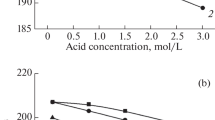Abstract
Amalgam fillings constitute, after food, the main source of exposure to mercury for the general population. An evaluation of potential health risks has to be based on the dose of mercury released from the fillings. This dose is estimated by a new procedure of mercury speciation which elutes the released elemental and inorganic mercury with solvents of different polarity (paraffin and saline). In vitro tests with spherical amalgam pellets have shown that mercury release into the solvents is linearily correlated to time and amalgam surface area. Doses estimated in volunteers by this method average 4.5 μg/day (range 0.3–13.9), as compared to a dose of 3.4 μg/day (range 0.1–11.8) measured conventionally in the oral air. The aforementioned dose, combined with the nearly equal mercury uptake from food, is below the acceptable daily intake of 40 μg for all forms of mercury.
Similar content being viewed by others
References
Begerow J, Zander D, Freier I, Dunemann L (1994) Long-term mercury excretion in urine after removal of amalgam fillings. Int Arch Occup Environ Health 66:209–212
Berglund A (1990) Estimation by a 24-hour study of the daily dose of intra-oral mercury vapor inhaled after release from dental amalgam. J Dent Res 69:1646–1651
Berglund A, Pohl L, Olsson S, Bergman M (1988) Determination of the rate of release of intra-oral mercury vapor from amalgam. J Dent Res 67:1235–1242
Brune D, Evjie DM (1985) Man's mercury loading from a dental amalgam. Sci Total Environ 44:51–63
Camner P, Bakke B (1980) Nose or mouth breathing? Environ Res 21:394–398
Clarkson TW, Friberg L, Hursh JB, Nylander M (1988) The prediction of intake of mercury vapor from amalgams. In: Clarkson TW, Friberg L, Nordberg GF, Sager PR (eds) Biological monitoring of toxic metals. Plenum Press, New York, pp 247–264
Derand T (1989) Mercury vapor from dental amalgams, an in vitro study. Swed Dent J 13:169–175
Drasch G, Schupp I, Riedl G, Günther G (1992) Einfluß von Amalgamfüllungen auf die Quecksilberkonzentration in menschlichen Organen. Dtsch Zahnärztl Z 47:490–496
Friese K-H, Roschig M, Wünscher G, Matschiner H (1990) A new calibration method for the determination of trace amounts of mercury in air and biological materials. Fresenius J Analyt Chem 337:860–866
Fritz U, Zellmann M (1991) Quecksilberabgabe aus Amalgamprüfkörpern. Dtsch Zahnärztl Z 46:553–554
Halbach S (1994) Amalgam tooth fillings and man's mercury burden. Hum Exp Toxicol 13:496–501
Hughes WL (1957) A physicochemical rationale for the biological activity of mercury and its compounds. Ann NY Acad Sci 65:454–460
Hursh JB (1985) Partition coefficients of mercury (203-Hg) vapor between air and biological fluids. J Appl Toxicol 5:327–332
Langworth S, Kolbeck KG, Akesson A (1988) Mercury exposure from dental fillings. II. Release and absorption. Swed Dent J 12:71–72
Magos L (1984) Mercury. In: Vercruysse A (ed) Hazardous metals in human toxicology, vol 4B. Elsevier, Amsterdam, pp 171–198
Marek M (1990) The release of mercury from dental amalgam: the mechanism and in vitro testing. J Dent Res 69:1167–1174
Nylander M, Friberg L, Lind B (1987) Mercury concentrations in the human brain and kidneys in relation to exposure from dental amalgam fillings. Swed Dent J 11:179–187
Okabe T, Ferracane JL, Cooper C, Matsumoto H, Wagner M (1987) Dissolution of mercury from amalgam into saline solution. J Dent Res 66:33–37
Olsson S, Bergman M (1987) Letter. J Dent Res 66:1288–1289
Ott KHR, Krafft T, Kröncke A, Schaller K-H, Valentin H, Weltle D (1986) Untersuchungen zum zeitlichen Verlauf der Quecksilberfreisetzung aus Amalgamfüllungen nach dem Kauen. Dtsch Zahnärztl Z 41:968–972.
Schiele R (1988) Quecksilberabgabe aus Amalgam und Quecksilberablagerung im Organismus. In: Institut der Deutschen Zahnärzte (eds) Amalgam-Pro und Contra. Deutscher Arzte-Verlag, Köln, pp 123–131
Silver SD (1946) Constant flow gassing chambers: principles influencing design and operation. J Lab Clin Med 31:1153–1161
US Department of Health and Human Services (1993) Dental amalgam. Appendix IV. US Public Health Service, Washington
Vimy MJ, Lorscheider FL (1985) Serial measurements of intra-oral air mercury: estimation of daily dose from dental amalgam. J Dent Res 64:1072–1075
WHO (1972) Evaluation of mercury, lead, cadmium and the food additives amaranth, diethylpropylpyrocarbonate and octyl gallate. WHO, Geneva, Food Additives Ser., NR. 4
WHO (1989) Evaluation of certain food additives and contaminants. WHO, Geneva, Tech. Rep. Series nr. 776
WHO (1991) Inorganic mercury. WHO, Geneva, Environmental Health Criteria, Nr. 118
Author information
Authors and Affiliations
Additional information
German patent nr. 4323072
Rights and permissions
About this article
Cite this article
Halbach, S. Estimation of mercury dose by a novel quantitation of elemental and inorganic species released from amalgam. Int. Arch Occup Environ Heath 67, 295–300 (1995). https://doi.org/10.1007/BF00385643
Received:
Accepted:
Issue Date:
DOI: https://doi.org/10.1007/BF00385643




